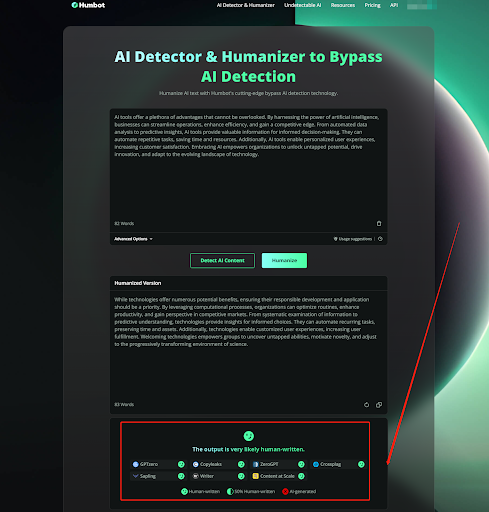In the rapidly advancing world of artificial intelligence (AI), with its myriad applications across various fields, ensuring the authenticity of AI-generated content has become both a priority and a challenge. Enter Humbot, a platform that claims to tackle this challenge head-on by offering services that seem to redefine the boundaries between AI-generated and human-generated content. This comprehensive review will delve into the core functionalities of Humbot, assess its effectiveness in AI detection and humanization, and explore its implications for content creators and the broader digital ecosystem.
Introducing Humbot: The AI Detector and Humanizer
Humbot emerges in a digital landscape rife with concerns over the detectability of AI-generated text. With AI’s growing role in content creation, the ability to discern between human and AI contributions has become crucial for maintaining integrity across educational, professional, and creative domains. Humbot purports to address these concerns by offering a suite of tools designed to not only detect AI-generated content but to also ‘humanize’ such content, effectively bypassing AI detection mechanisms.
AI Detector: The Foundation of Trust
The platform’s AI detector is a critical aspect of its offerings. Positioned as an AI checker, it aims to provide an added layer of reassurance to content creators and end-users by analyzing texts to identify possible AI origins. This tool, according to Humbot, can seamlessly integrate detection results from popular AI detectors, thus promising comprehensive coverage in identifying AI-generated contents.
Humanize AI Text: The Art of Camouflage
One of the more controversial yet intriguing features of Humbot is its capacity to ‘humanize’ AI-generated text. This process entails reworking the AI’s output to mask its digital fingerprints, thereby making it more difficult for AI detectors to identify its origins. This AI humanizer, or as Humbot positions it, the anti AI detector, raises interesting questions about the future of content creation and the ongoing cat-and-mouse game between content authenticity tools and methods designed to circumvent them.
The Ethics of AI Humanization
The intersection of AI and ethics is a contentious arena, and Humbot’s ability to humanize AI text brings this debate to the forefront. While the tool offers significant advantages, such as aiding content creators in presenting AI-assisted work as human-generated, it also opens the door to potential misuse. The ethical implications of disguising AI-generated work are complex, necessitating a careful examination of intent, application, and impact.
Who Stands to Benefit?
Humbot’s target audience includes a broad spectrum of users, from content creators to marketers, and even academic professionals. The platform’s ability to bypass AI detection is pitched as a boon for those seeking to blend AI-generated content seamlessly with human contributions. However, it’s essential to consider the platform’s guidelines and the moral responsibility of the users to employ these tools judaciously and ethically.
Analyzing Quality and Originality
Quality is a paramount concern when it comes to content, regardless of its origin. Humbot’s promise of high-quality, humanized text—free of grammatical errors and retaining the informational essence of the original AI-generated content—is an ambitious claim. The question of whether the humanization process can consistently produce unique, engaging, and error-free content is central to evaluating Humbot’s value proposition.
Originality and Plagiarism Concerns
In the realm of content creation, originality is not just a metric of quality but a legal and ethical standard. Humbot’s assertion of producing original output, with a low to zero plagiarism score, is compelling. This claim, if substantiated, could position Humbot as a significant ally for content creators aiming to leverage AI’s power while navigating the complexities of intellectual property rights and plagiarism detection algorithms.
User Experience and Accessibility
Ease of use is a critical factor in the adoption and success of any digital tool. Humbot’s design philosophy, centered around novice-friendliness and fast, efficient processing, aims to lower the bar for entry into AI-assisted content creation and modification. The platform’s user interface, process simplicity, and speed of delivery are therefore crucial aspects of its appeal to a broad user base.
The Cost of Innovation
With advanced capabilities comes the question of accessibility, particularly in terms of cost. Humbot’s pricing strategy, the value it delivers versus its affordability, and the availability of any free trials or demos could significantly influence its adoption rate. Assessing the platform’s cost against its potential to save time, enhance content quality, and ensure originality will be an essential consideration for potential users.
Conclusion: The Future of Content Creation and AI Detection
Humbot represents a fascinating evolution in the ongoing development of AI technologies and their application in content creation. By offering tools to detect and humanize AI-generated content, it addresses a growing need within the digital content ecosystem. However, the effectiveness, ethical implications, and broader impacts of such technologies warrant careful consideration.
As we step further into an age where AI’s role in content creation continues to grow, platforms like Humbot are set to play a pivotal role. Their ability to bridge the gap between human and AI contributions, while ensuring the integrity and originality of the final output, will be closely watched by content creators, ethical observers, and the AI community alike.
In this nuanced landscape, Humbot’s contributions are both promising and deserving of critical scrutiny. The platform’s success and the ethical considerations it presents underscore the complex interplay between innovation, utility, and responsibility in the digital age.






